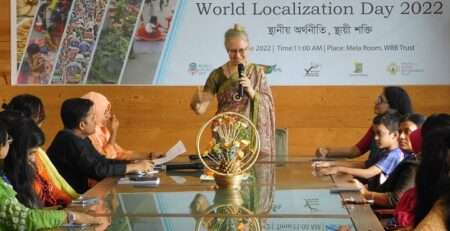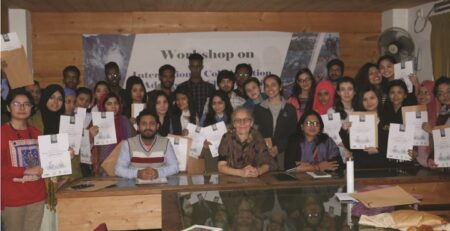What Could Indigenous People Teach Us About Preserving the Environment?
–Smriti Neupane, Poonam Dhaulakoti, and Mrasin U
Students, Asian University of Women; interns, Institute of Wellbeing
It is hard to deny that the world is facing major crises, from the loss of much of our diversity to the ever-worsening climate crisis. The worldwide fixation on economic growth has helped lift millions of people out of poverty, but at what cost, and for how long can we sustain a system that treats profit as more important than the planet? Perhaps there is something that we can learn from indigenous peoples who have been on this planet for thousands of years, developing a lifestyle that enables survival without environmental destruction.
The Rautes are one of 59 legally recognized indigenous nationalities in Nepal. They have sustained their unique cultural identities for generations. They are the only nomadic people in the country: they never settle permanently in any particular place. The fact that the Rautes, the last fulltime nomads of Nepal, have survived into this century is truly remarkable. To eke out their living, they mastered the craft of wooden products, learned to hunt monkeys, and adapted to forest life. While there has been much debate on property rights in Nepal and many conflicts for the rights of the land, the Rautes do not wish to be attached to any particular land and enjoy living in their traditional nomadic ways.
The Rautes also bear traditional knowledge of living in a community. Humanity has a lot to learn from the Rautes, since they have been very successful in preserving their tradition in today’s world. Their maintenance of the nomadic culture in a rapidly globalising world is commendable. This global uniqueness makes them a precious part of the diverse people of Nepal. We also have much to learn from their ability to live from the forest without destroying it.
The Chepang are an indigenous Tibeto-Burman community inhabiting the ridges of the Mahabharat mountain range of central Nepal. They usually live in caves or thatched houses, relying increasingly on the production of crops such as maize, millet and bananas. The Chepang have often been characterized as the poorest of Nepal’s poor and many are illiterate. Chepang men and women are basically egalitarian and no social ranking exists as it does in Nepalese caste society.
The variety in the relationships between indigenous peoples and the forests they utilize are extremely diverse. The general ability of people to conserve the forests they depend upon for their livelihood is questioned by some while supported by others. Given that many rural people in developing countries rely on a host of forest products for their livelihood, rather than asking whether indigenous peoples can conserve the forest it seems more appropriate to ask under what conditions this is possible. In the Chepang community, the forest is used as an important source of food, fibre, medicine, housing materials, firewood and fodder. Products are collected for personal consumption, barter and sale.
While influenced by both Hinduism and Buddhism, the Chepang are animists, believing that holy spirits live in plants, animals, rivers and mountains, and with whom they need to maintain good relations through sacrifices and other forms of respect. Disrespect for the holy spirits is believed to be the cause of disease and natural disasters. Hunting of mammals, birds, and insects is only for subsistence and traditional rules forbid the killing of females of the species, thereby (in their belief) reducing the impact on wild populations.
Being highly dependent on the natural environment, the Chepang community finds the preservation of a stable climate essential to their livelihood. Agriculture alone would never feed them enough; despite being an agricultural country, people engaged in agriculture in Nepal still suffer because of poverty. If the forest became extinct, they would not survive. The Chepang worship and preserve the forests so that they won’t have to die of hunger. Their emphasis on living in harmony with the environment offers important lessons about reducing natural calamities by respecting Mother Nature and taking her warnings seriously.
This is not to ignore the poverty, lack of formal education, and many health problems from which indigenous people suffer. But how much of those problems is a result of their lifestyle, and how much the result of other groups pushing them to the fringe and destroying many of the forests that were formerly the source of their livelihood? We can both acknowledge that groups like the Rautes and Chepang have many serious difficulties and that they have much to teach us about living in harmony with the natural environment that, whether we acknowledge it or not, sustains us all.













Leave a Reply